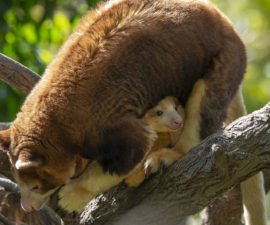BY Karyl Carmignani
Photography by Ken Bohn
Videography by Sharyn Umana-Angers
The rhinoceros is the second-largest land mammal, behind the elephant. These stocky, Land Rover-sized vegetarians once numbered over 500,000, but they have been reduced to about 29,000 in recent years, largely due to humans’ appetite for their signature appendage: the horn. Of the five rhino species, one is a conservation success story (southern white), three are critically endangered (black, Sumatran, Javan), and one is listed as vulnerable (greater one-horned), according to the International Union for Conservation of Nature (IUCN). The current rate of poaching is unsustainable for all rhinos. Subspecies of black and Javan rhinos have already slipped into extinction. Northern white rhinos are hanging on by a fingernail; after Nola passed away at the Safari Park in 2015, only three remain on the planet. For both “splitters” and “lumpers” of species and subspecies, the downward trend is heartbreaking.
GREAT NEWS!
Meet our newest greater one-horned rhino calf trotting around the Safari Park.
With all the brouhaha about rhino horn, what exactly is it made of? Turns out, rhino horn is made of keratin like our hair and fingernails, with deposits of calcium and melanin in the core, so it is similar to horse hooves and turtle beaks (see our recent Rhino Horn Burn article). Scientists say the calcium makes the horn stronger while the melanin protects it from the sun’s UV rays. Rhino horns tend to curve backward toward the animal’s head because the keratin in the front grows faster. The outer layers are somewhat soft and can be worn down after years of use.
Rhinos inhabit savannas and forests in tropical and subtropical regions. Africa has two species, both with two horns: the white rhino Ceratotherium simum and black rhino Diceros bicornis. The Asian rhinos are the greater one-horned Rhinoceros unicornis and Javan rhino R. sondaicus, both with one horn, and the Sumatran rhino Dicerorhinus sumatrensis, with two horns.
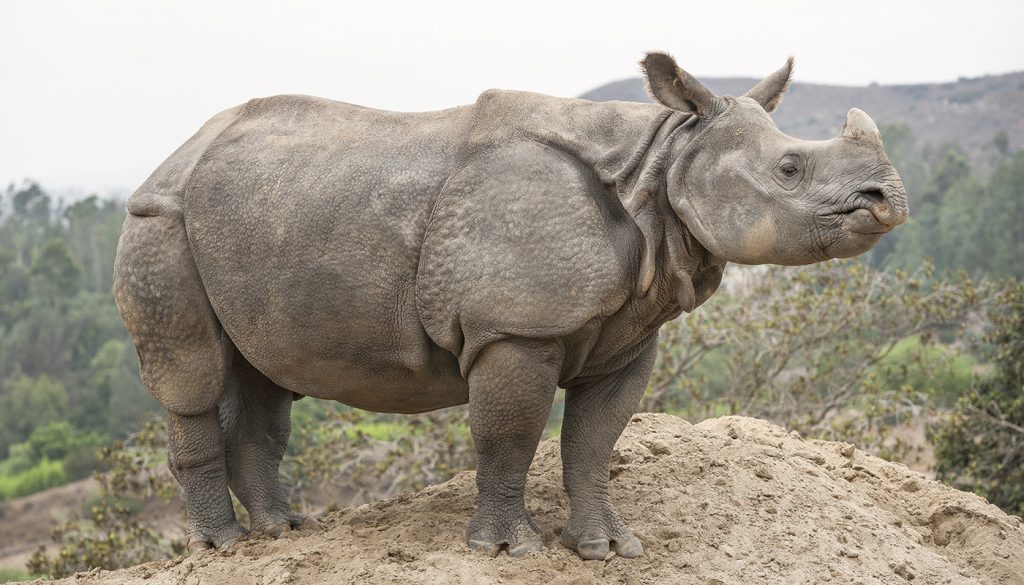
HEAVY ARMOR, BUT NOT SAFE
Though the greater one-horned rhino’s thick skin resembles armor, this species remains vulnerable.
Before you head off on an African safari to test your rhino knowledge, note that white rhinos aren’t white and black rhinos aren’t black. Luckily, there are other telltale signs of which is which. The white rhino is the largest, tipping the scales at 4,000 to 5,000 pounds and standing 5 to 6 feet tall at the shoulder. It has a long forehead, a muscular bulge (called a nuchal hump) on the top of its neck, and holds its head low while resting. But the best way to tell them apart is also what keeps them out of each other’s way at mealtime: mouth shape! The white rhino has a wide, flat upper lip for mowing grass, while the black rhino has a hooked, prehensile lip for grasping and browsing on trees and shrubs. The two species do not compete for the same resources, since one is a grass grazer and the other a tree trimmer.
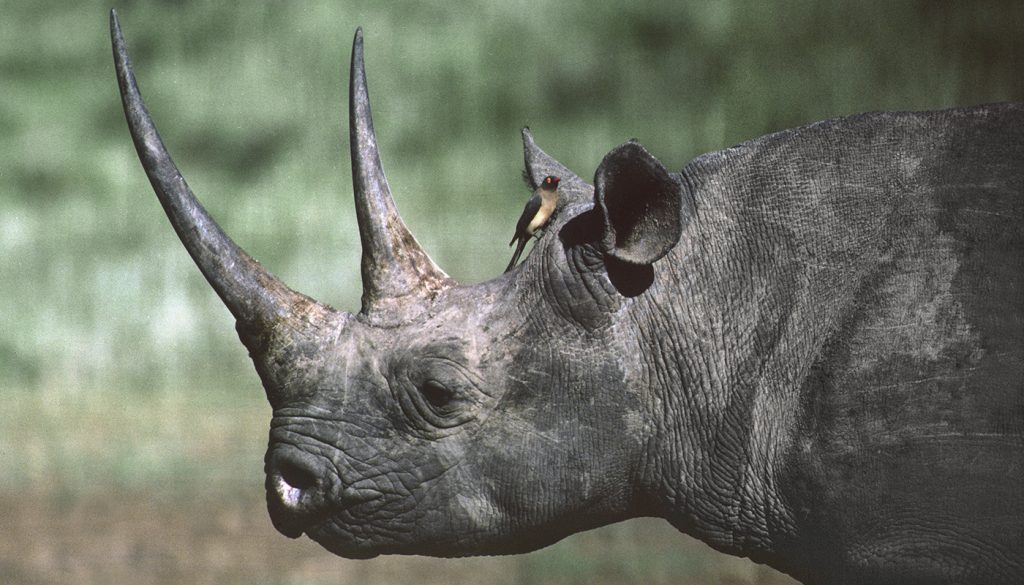
RARE AND WONDEROUS
The hook-lipped black rhino is critically endangered.
It is thought that the white rhino’s name was derived from the Afrikaans word “weit,” meaning wide, to describe its mouth. Black rhinos probably earned their name from their wallowing lifestyle and the dark mud on their skin. Both can produce 50 pounds of dung a day, and both species scrape the dung pile with the rear feet, flinging it and leaving two parallel foot skids through the pile as a form of communication.
The southern white rhino has fared much better than its northern brethren, which have become functionally extinct with only three individuals remaining. The southern white rhino, found primarily in South Africa, had been relentlessly hunted to near extinction in the early 1900s. A surviving population of 100 was rounded up and protected in a national park in South Africa. Today, southern white rhinos are a conservation success story, as their numbers now exceed 20,000. However, rampant poaching remains a chronic threat.
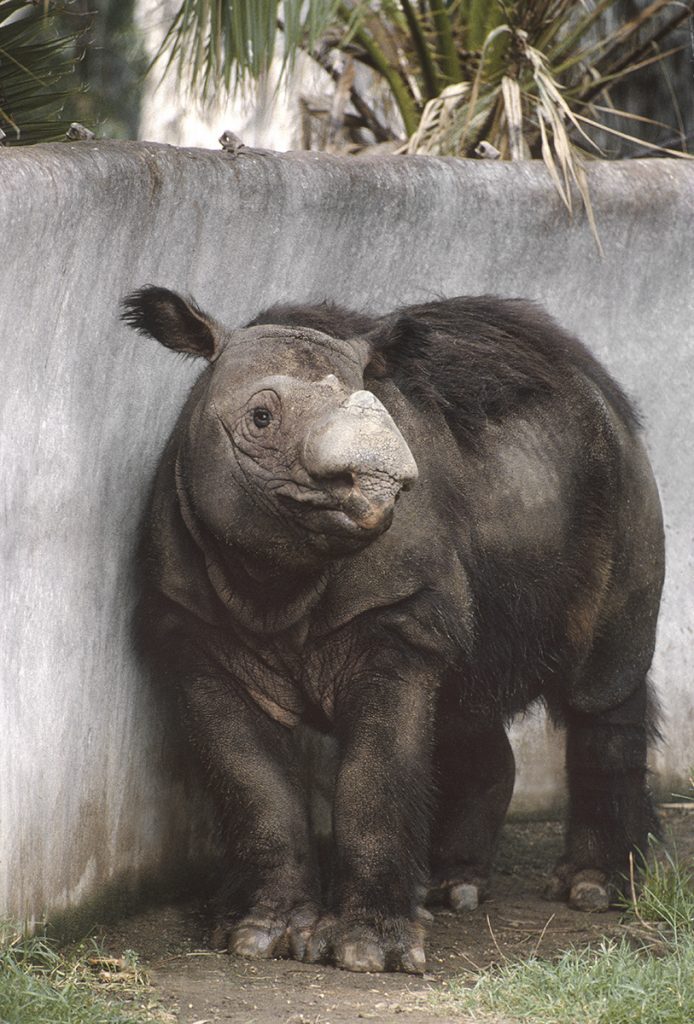
THE HAIRY ONE
Sumatran rhinos are the smallest and hairiest rhino species.
The Mysteries of Asian Rhinos
Of the three rhino species surviving in Asia—Sumatran, Javan, and greater one-horned—only one is showing conservation recovery while the other two are on the cusp of extinction. The greater one-horned rhino has risen from the critically endangered dust: in the 1900s, its numbers plummeted to about 200 animals, but today 3,330 animals live throughout India and Nepal. While reintroduction projects have begun, poaching and habitat loss remain a looming threat. Will its thick, armor-like folds of skin ward off extinction?
The most threatened species is the solitary Javan rhino, numbering about 60 individuals in one national park in Java, Indonesia. According to the Asian Rhino Project, work has begun to expand the rhinos’ habitat by relocating illegal human settlers; eradicating the arenga palm, an invasive plant that prevents the undergrowth (rhino food) from flourishing; and replanting suitable rhino greens. The Javan rhino sports one horn, and the female’s horn is virtually non-existent, which could discourage poaching. Sadly, the last Javan rhino in Vietnam was felled by a poacher’s bullet in 2010.
The hairiest rhino is the only two-horned rhino in Asia: the Sumatran. It is also the most petite, weighing in at about 1,320 to 2,000 pounds and measuring 3.3 to 5 feet tall at the shoulder. They are more closely related to the now-extinct woolly rhino than the other four rhino species. Only the Sumatran and greater one-horned rhinos have canine teeth, which they use to slash and gouge at enemies.
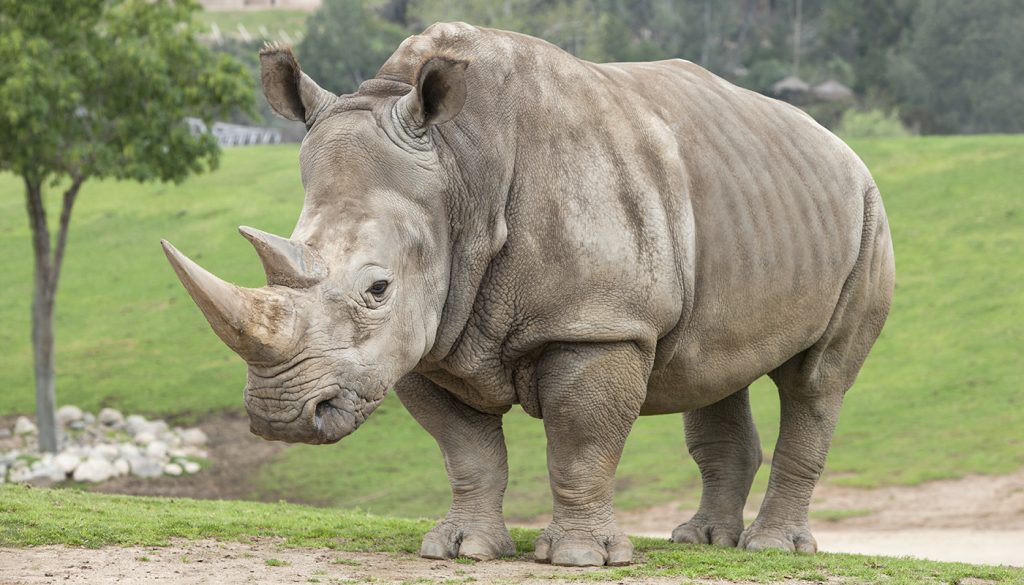
RISING FROM THE ASHES
The southern white rhinoceros was a conservation success story, but now it faces heavily armed, relentless poachers.
Making It through History
The rhinoceros is an odd-toed ungulate known as a perissodactyl, related to tapirs, horses, and zebras. The earliest known odd-toed, rhinoceros-like mammal appeared during the middle of the Eocene epoch (56 to 33.9 million years ago) and was the size of a large dog, with hooves, plant-eating dentition, and no horns. Three families of rhinos evolved in the late Eocene: Hyracodontidae (running rhinos), Amynodontidae (aquatic rhinos), and ancestors of modern rhinos, Rhinocerotidae. This compact variety was distributed throughout the world, including North America. It died out there about 4 million years ago, while the jumbo-sized, two-horned woolly rhinoceros flourished in Eurasia up until the last Ice Age. It went extinct around 12,000 years ago, most likely due to humans hunting it for its meat and thick fur pelt.
Of the remaining rhinos, the greater one-horned rhino appears to be the oldest modern lineage, followed by the Sumatran rhino a million years later. The new species on the block—geologically speaking—are the African rhinos, which appeared about 17 million years ago. DNA evidence shows white and black rhinos diverging from a common ancestor about 2 million years ago, while fossil evidence indicates an earlier departure of 7 to 8 million years ago.
All in all, rhinos have been quite successful, grazing and browsing their way across history virtually unbothered by predators—until humans and their high-powered weapons arrived on the scene. Now it is up to humans to change their ways and make the right decisions to keep the remaining rhinos safe, so these magnificent animals will still share the planet with us into the future.


